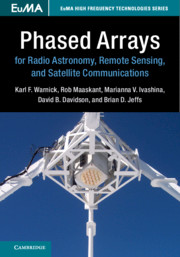Book contents
- Frontmatter
- Contents
- Preface
- Acknowledgements
- Notation and Units
- 1 Phased Arrays for High-sensitivity Receiver Applications
- 2 Active Antenna Receivers
- 3 Antenna Examples
- 4 Transmitting Arrays, Network Analysis, and Pattern Overlap Integrals
- 5 Array Receiver Theory and Modeling
- 6 Figures of Merit for Active Receiving Arrays
- 7 Design and Optimization of Phased Array Antennas
- 8 Numerical Modeling of Phased Array Antennas
- 9 Analog Front End, Array Elements, and Receiver Electronics
- 10 Array Signal Processing, Calibration, and Beamforming
- 11 Interferometric Arrays and Synthesis Imaging
- 12 Real Time Digital Signal Processing
- Index
- References
5 - Array Receiver Theory and Modeling
Published online by Cambridge University Press: 14 July 2018
- Frontmatter
- Contents
- Preface
- Acknowledgements
- Notation and Units
- 1 Phased Arrays for High-sensitivity Receiver Applications
- 2 Active Antenna Receivers
- 3 Antenna Examples
- 4 Transmitting Arrays, Network Analysis, and Pattern Overlap Integrals
- 5 Array Receiver Theory and Modeling
- 6 Figures of Merit for Active Receiving Arrays
- 7 Design and Optimization of Phased Array Antennas
- 8 Numerical Modeling of Phased Array Antennas
- 9 Analog Front End, Array Elements, and Receiver Electronics
- 10 Array Signal Processing, Calibration, and Beamforming
- 11 Interferometric Arrays and Synthesis Imaging
- 12 Real Time Digital Signal Processing
- Index
- References
Summary
The treatment of single antennas in Chapter 2 introduced key concepts for receivers, including gain, directivity, effective area, impedance matching, noise figure, equivalent noise temperature, signal to noise ratio, and sensitivity. The treatment was then extended in Chapter 4 to arrays of transmitting elements. We now turn our attention to the main focus of the book, modeling high-sensitivity receiving antenna arrays.
For transmitters, the distribution of the signal power radiated by the antenna system is the primary consideration. Noise radiated by a transmitter is usually of secondary importance. For receivers, both the signal and noise response of the system are important, and the ultimate figure of merit for the performance of the system is the ratio of received signal of interest to the system noise (SNR). For this reason, the treatment of receiving arrays is more complicated than transmitters, as system noise must be brought into the analysis.We will begin by extending the network theory treatment developed in Chapter 4 to receiving arrays, and then bring in the noise modeling concepts that were introduced in Chapter 2.
Receiving Array Network Model
As a model for a receiving array, we will consider a basic narrowband active receive array architecture consisting of antenna elements terminated by low noise amplifiers, followed by receiver chains and a beamforming network which applies a complex gain constant (magnitude scaling and phase shift) to the signal from each element and sums the weighted signals to form a single scalar output, as in Fig. 5.1.
The canonical block diagram shown in Fig. 5.1 can represent many different types of antenna array receiver systems used in a variety of applications, and there are many variations on this basic architecture. Signals may be combined with an analog network, or the beamforming can be done using sampling followed by digital signal processing. For broadband applications, beamforming can be done with a time delay network, but more commonly the signal is processed digitally in frequency subbands using a narrowband beamformer architecture. Digital signal processing systems can form many simultaneous beams, so that the beamformer block is repeated in parallel for each formed beam.
- Type
- Chapter
- Information
- Publisher: Cambridge University PressPrint publication year: 2018



